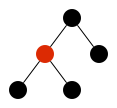Homework 1: Inductive definitions and proofs
- Due: 09/02 at 11:59pm
- Points: 30
Please prepare your solutions as a PDF file (scanned handwriting is okay, but no .doc or .docx, please) and submit in Canvas.
1. Red-black trees: definition
In class, we saw a definition of binary trees whose nodes are labeled with integers.
Here’s a definition of binary trees whose nodes are colored either
red or black. It defines a judgement t bintree that holds
if and only if t is a binary tree with red or black
nodes.
t1 bintree t2 bintree
——————————————————————— c ∈ {red,black}
c(t1,t2) bintree
————————— c ∈ {red,black}
c bintreeRemember that we represent trees as symbolic expressions. For
example, the tree drawn in Figure 1 is represented as
black(red(black,black),black).

- Write a definition of the judgement
t rbtreethat holds ifftis a binary tree whose colors satisfy the rules for red-black trees:
The root is black.
The leaves are black.
If a node is red, then both its children are black.
For each node, there is a number b (called its black-height) such that every path from the node to a leaf has exactly b black nodes.
Hint: First define the “helper” judgement
t rbtree(c,b), which holds ifftis a red-black tree with root colorcand black-heightb. (For this “helper” judgement only, the requirement that the root is black is not enforced.) Then definet rbtreein terms oft rbtree(c,b).
- Write a proof tree that shows that the tree shown in Figure 1 is a red-black tree.
2. Red-black trees: height bound
Define the height of a tree to be the maximum number of edges in a path from root to leaf. (Yes, it’s strange that black-height counts nodes but height counts edges.) You learned in Data Structures, but may not have proven, that the height of a red-black tree is O(log n), which makes them good for implementing dictionaries.
Prove, by induction(s) on the structure of derivations, that a red-black tree with n nodes has height at most 2 log2 (n+1) − 2. Hint: Do this in three steps:
Prove that if
t rbtree(c,b), thenthas n ≥ 2b − 1 nodes.Prove that if
t rbtree(c,b), thenthas height h ≤ 2b − 1 if c is red, and h ≤ 2b − 2 if c is black.Conclude that h ≤ 2 log2 (n+1) − 2.
Note: This is the last time you will see a logarithm in this class!
3. Semantics of NB
Due on Monday 09/05 at 11:59pm
Using small-step semantics (with or without evaluation contexts – your choice), show that
if iszero (pred (succ zero)) then false else true ⟶ if iszero zero then false else true.Show that
if iszero (pred (succ zero)) then false else true ⟶* falseusing a sequence of reductions, that is, fill in the...below:if iszero (pred (succ zero)) then false else true ⟶ if iszero zero then false else true ... ⟶ falseIt’s enough to write the sequence of reductions; you don’t have to prove each step.
Using big-step semantics, show that
if iszero (pred (succ zero)) then false else true ⇓ false(corrected 09/01)